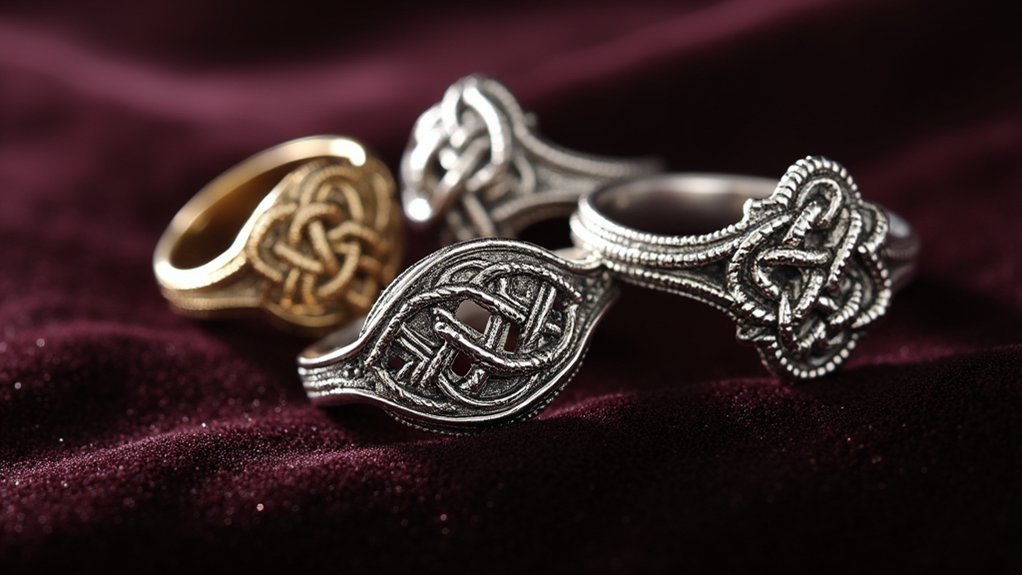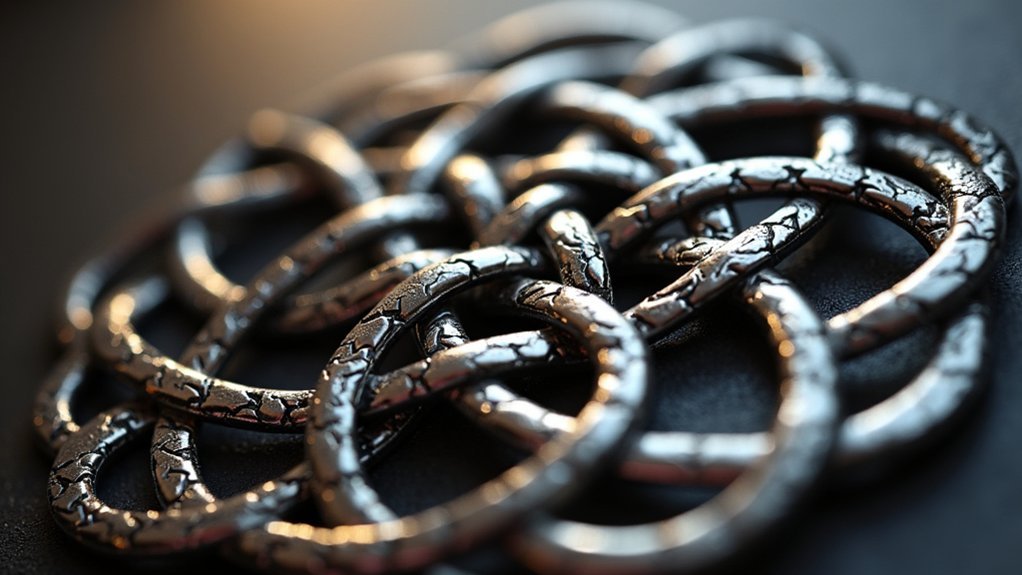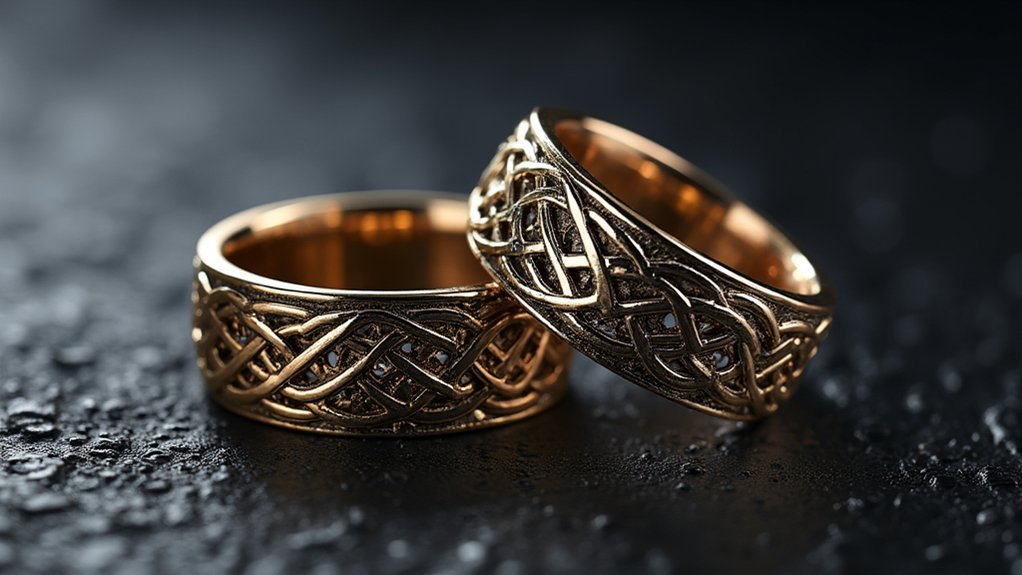You can easily create digital Celtic knot patterns by using vector-based software like Adobe Illustrator or Inkscape to trace traditional motifs with precision. Import reference images and use vector tools to capture authentic curves and endless loops while maintaining symbolic meaning. Apply color coding systems: red for engraving, black for cutting, and blue for reference lines to streamline laser cutting production. Scale designs proportionally around 37mm pendant height for ideal detail preservation. Master these fundamental techniques to access advanced workflow strategies for professional-quality digital Celtic jewelry manufacturing.
Understanding Celtic Knot Symbolism in Digital Design

Celtic knots carry profound spiritual meaning that translates beautifully into digital jewelry design. When you’re creating these intricate patterns, you’re working with symbols that represent life’s interconnectedness and existence’s continuity. Each Celtic knot tells a story through its endless loops and interwoven lines.
The Trinity Knot stands as the most recognizable design, symbolizing Christianity’s Holy Trinity. You’ll find its three-pointed structure perfect for digital manipulation using intersecting curves in vector software.
The Trinity Knot’s three-pointed structure makes it ideal for vector design while preserving its sacred Christian symbolism.
Celtic Spiral Knots offer another powerful option, representing the balance between your inner and outer self through circular forms and arcs.
Digital design tools let you precisely craft these meaningful symbols while maintaining their spiritual essence, ensuring your jewelry pieces carry both aesthetic beauty and deep cultural significance.
Essential Software Tools for Creating Celtic Patterns
Digital craftsmanship requires the right tools to transform your Celtic knot concepts into professional jewelry designs.
Adobe Illustrator, CorelDRAW, and Inkscape offer vector graphics capabilities essential for precise Celtic knots creation. You’ll find AutoCAD particularly valuable for its robust drafting features that enable detailed customization of intricate knot patterns.
For streamlined workflow, consider the Celtic Knot Font program, which lets you create traditional knotwork patterns quickly and integrate them seamlessly into your projects.
If you’re using cutting machines, Silhouette Studio and Brother CanvasWorkspace provide user-friendly interfaces for design preparation and production.
Maximize your efficiency by utilizing layers in your chosen software. This organizational approach helps you distinguish between engraving, cutting, and drawing paths while ensuring proper color coding aligns with your production requirements.
Vector-Based Design Techniques for Intricate Knotwork

You’ll master Celtic knotwork by employing precision arc construction methods that guarantee your curves flow smoothly and maintain consistent proportions throughout complex interlacing patterns.
Color-coded layer systems become your organizational backbone, allowing you to assign specific colors like red for engraving paths and black for cutting lines while keeping each design element clearly separated.
These techniques transform intricate Celtic designs from overwhelming puzzles into manageable, systematically constructed artworks that translate seamlessly to jewelry production.
Precision Arc Construction Methods
When designing intricate Celtic knotwork for jewelry, precision becomes paramount as even minor deviations can disrupt the flowing, interconnected patterns that define these ancient motifs.
You’ll achieve accurate proportions by overlaying arcs over reference images of traditional Celtic knot designs using vector-based software like AutoCAD or Adobe Illustrator.
Start by creating your base arcs, then employ the trim tool to refine edges for smooth intersections. Use the rotate tool to align arcs into circular formations that capture the interconnected essence of Celtic designs.
Mark critical break and overlap points with circles to maintain symmetry throughout your pattern.
Implement color coding—red for engraving, black for cutting, blue for drawing—to streamline your CNC laser production workflow and guarantee flawless translation from digital design to finished jewelry pieces.
Color-Coded Layer Systems
Mastering color-coded layer systems transforms complex Celtic knotwork into manageable design components that’ll streamline your entire production workflow.
You’ll use red for engraving details, black for cutting paths, and blue for drawing guidelines when preparing files for CNC laser machines. This standardized approach guarantees your Celtic knot designs translate perfectly from screen to physical production.
Layer separation lets you isolate individual elements within intricate knotwork, making edits precise and efficient. You can toggle visibility, adjust specific components, and maintain design integrity throughout the creation process.
Vector-based software like Adobe Illustrator or CorelDRAW supports advanced layer management, giving you complete control over every strand and intersection. The scalable nature of vector designs means your Celtic knot patterns adapt seamlessly to different pendant sizes while maintaining crisp detail.
Color Coding Systems for Laser Cutting Applications
Since laser cutting machines rely on visual cues to execute different operations, understanding color coding systems becomes essential for creating precise Celtic knot jewelry designs.
You’ll need to assign red for engraving intricate details, black for cutting through material, and blue for drawing reference lines. This standardized approach aids your CNC laser machine differentiate between operations automatically.
When designing Celtic knot patterns, you should prepare files in vector formats like CDR, SVG, AI, or DXF with proper color assignments.
Red works perfectly for engraving the detailed interwoven patterns that make Celtic knot jewelry distinctive. Black handles the cutting operations that separate individual pieces from your material sheet.
Using consistent color coding streamlines your workflow, reduces production errors, and guarantees your intricate designs execute correctly every time.
Scaling and Proportioning Digital Celtic Designs

When you’re scaling Celtic knot designs, you’ll need to maintain ideal size ratios that preserve the intricate details while fitting your intended jewelry proportions.
Your design’s visual balance depends on adjusting each element proportionally—if you enlarge the pendant from the standard 37 mm height, make sure all line weights and spacing scale uniformly.
You can achieve precise scale adjustments by using the vector format’s scalability features, which let you resize without losing the crisp edges essential for laser cutting applications.
Optimal Size Ratios
Success in Celtic knot jewelry design hinges on achieving the perfect balance between intricate detail visibility and practical wearability.
You’ll want to target approximately 37 mm for pendant height as your baseline measurement, though you can adjust this based on your specific requirements and personal preferences.
When determining ideal ratios, maintain the aspect ratio religiously to preserve your Celtic knot patterns’ integrity.
Distortion ruins the mathematical precision that makes these designs so enchanting.
Test your scaled designs on smaller pieces first—this approach helps you identify proportion issues before committing to larger projects.
Use vector formats like SVG and AI files for scaling flexibility without quality loss.
This guarantees your knotwork maintains crisp, clean lines regardless of size adjustments, giving you professional results every time.
Proportional Design Balance
Building on these size fundamentals, you’ll discover that proportional design balance becomes your most powerful tool for creating stunning Celtic knot jewelry. Your 37 mm pendant height serves as the foundation for maintaining intricate pattern integrity across different scales.
When you’re adjusting dimensions, keep every element proportional to preserve the Celtic knot’s visual harmony. You’ll need to take into account your material thickness—like 4 mm poplar—when scaling designs to confirm structural stability doesn’t compromise aesthetics.
Use your color-coded system consistently: red for engraving details, black for cutting lines, and blue for reference marks. This approach maintains clarity regardless of size adjustments.
Vector formats like SVG and AI guarantee quality retention during scaling, making your Celtic knot designs perfectly suited for CNC laser production.
Scale Adjustment Techniques
As you master proportional balance, effective scale adjustment techniques will transform your digital Celtic designs into precise, manufacturable pieces.
You’ll need to maintain aspect ratios when resizing your Celtic knot patterns—hold Shift while scaling in design software to prevent distortion. For CNC laser cutting, adjust your design to fit 37mm pendant height while accounting for 4mm poplar thickness.
Use vector formats like SVG or AI files since they scale without quality loss, preserving your Celtic knot’s intricate details.
Always consider visual harmony when resizing—ensure knot elements remain balanced and symmetrical at different scales.
Before committing to your final cut, test the scaled design on smaller material samples. This allows you to fine-tune proportions and scaling adjustments, guaranteeing your Celtic knot achieves the desired appearance.
File Format Optimization for CNC Manufacturing

How can you guarantee seamless compatibility between your Celtic knot jewelry designs and CNC manufacturing equipment?
You’ll need properly optimized file formats that speak your machine’s language directly.
The digital download provides five essential vector formats: CDR, SVG, PDF, AI, and DXF. Each format guarantees your Celtic knot designs translate perfectly to CNC laser machines without conversion headaches.
You’ll find intuitive color coding throughout every file – red indicates engraving areas, black marks cutting paths, and blue shows drawing lines. This system eliminates guesswork during production setup.
These files are specifically calibrated for 4mm thick poplar, matching industry-standard CNC materials.
Since you receive immediate access post-purchase, you can integrate these optimized formats into your production workflow instantly, reducing setup time and maximizing manufacturing efficiency.
Traditional Motifs Adapted for Modern CAD Systems
While Celtic artisans once carved their intricate knotwork by hand, you can now transform these ancient patterns into precise digital blueprints using modern CAD systems.
You’ll start by importing reference images of traditional Celtic knot designs directly into your CAD software. Using vector tools, you can trace these complex patterns with remarkable accuracy, capturing every curve and intersection.
Layer management becomes essential for organizing your design elements. You’ll separate cutting paths, engraving details, and reference drawings into distinct layers, giving you complete control over each component.
Scale adjustment features let you resize any Celtic knot pattern to fit different pendant dimensions while preserving the intricate details that make these designs so engaging. This digital approach maintains the authentic beauty of traditional motifs while embracing modern manufacturing precision.
Workflow Strategies for Multi-Format Pattern Export

Once you’ve perfected your Celtic knot design in CAD, you’ll need to export it in multiple formats to guarantee compatibility across different CNC laser machines and software platforms.
Your export workflow should include these essential formats:
| Format | Purpose | Celtic Jewelry Use |
|---|---|---|
| CDR | CorelDRAW projects | Complex pendant designs |
| SVG | Web compatibility | Scalable ring patterns |
| AI | Adobe Illustrator | Professional finishing |
Implement strategic color coding throughout your Celtic jewelry pieces—red for engraving intricate knotwork details, black for cutting outer pendant shapes, and blue for marking reference points. Set your pendant height to 37 mm consistently, enabling easy scaling later.
Organize exported files in clearly labeled folders within your digital archive. Include format-specific instructions for each file type to ascertain customers can successfully import and modify your designs across various CNC systems.
Quality Control Methods for Digital Celtic Jewelry Files
Establish a systematic review process that validates every digital Celtic jewelry file before release, checking each format—CDR, SVG, PDF, AI, and DXF—for proper color coding, dimensional accuracy, and cross-platform compatibility.
Every digital Celtic jewelry file undergoes rigorous validation across all formats to ensure flawless color coding, precise dimensions, and seamless cross-platform functionality.
You’ll need to verify that red indicates engraving paths, black shows cutting lines, and blue represents drawing elements.
Test your Trinity Knot designs on 4mm poplar samples to assess precision and adjust parameters accordingly.
Create an extensive checklist confirming pendant dimensions meet the 37mm height requirement and designs scale properly across different sizes.
Implement version control documentation for any design modifications, ensuring consistency with customer expectations.
Quality control methods for digital Celtic jewelry files should include regular customer feedback collection through surveys, helping you identify usability issues and improve future releases.
Frequently Asked Questions
Can I Sell Jewelry Made From Downloaded Celtic Knot Digital Patterns?
You’ll need to check the license terms for each pattern you download. Some patterns allow commercial use while others restrict sales. Read licensing agreements carefully before creating and selling jewelry from downloaded designs.
What’s the Typical Cost Range for Professional Celtic Pattern Design Software?
You’ll find professional Celtic pattern design software ranging from $50-200 for specialized programs, while extensive CAD software with Celtic capabilities costs $300-2,000+ depending on features and licensing options.
How Long Does It Take to Learn Basic Celtic Knot Design?
You’ll grasp basic celtic knot principles within 2-3 weeks of regular practice. Simple patterns become manageable after a month, while complex interwoven designs typically require 3-6 months to master confidently.
Are There Free Alternatives to Expensive Celtic Jewelry Design Programs?
You can use free software like Inkscape, GIMP, or Krita instead of costly programs. Traditional graph paper and pencil work perfectly too. Online generators and tutorials also help you create beautiful patterns without spending money.
Can Celtic Knot Patterns Be Modified for Different Cultural Markets?
You can adapt celtic knot patterns by incorporating colors, symbols, and motifs meaningful to different cultures. You’ll modify line thickness, add geometric elements, or blend traditional celtic interlacing with local artistic traditions successfully.
In Summary
You’ve now mastered the essential techniques for creating stunning digital Celtic knot patterns. Don’t let traditional complexity intimidate you—modern software makes intricate designs achievable. You’ll save countless hours by implementing proper workflows and file optimization from the start. Your laser cutters and CNC machines will thank you for clean, scalable vector files. Start with simple knots, then build complexity as you’re comfortable with your digital toolset.





Leave a Reply